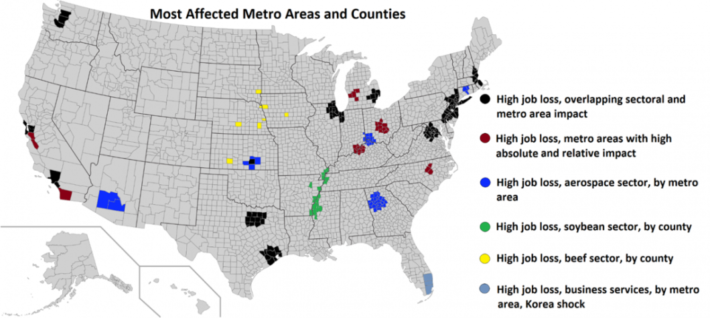Last year, in the context of the political campaign, and Donald Trump’s pledge to get tough with our trade partners, Sherman Robinson, Tyler Moran, and I did some modeling of what trade wars with China and Mexico might look like. One of the things we did was look at scenarios, in which rather than responding in kind, with across-the-board tariffs, China responded asymmetrically, targeting particular US industries.
Specifically, we looked three illustrative scenarios: a Chinese halt to aircraft purchases, an instruction to state-owned enterprises to stop buying US business services, and a soybean embargo. Problems with the way the necessary data is collected prevented us from examining a corn embargo, and the prevention of Chinese students coming to the United States for higher education.
Working with Sherman, Egor Gornostay, and Kent Boydston, we updated the model and investigated a couple of KORUS dissolution scenarios. In this application, the motivation would not be a foreign partner imposing retaliation but rather the removal of preference margins created by the free trade agreement (FTA). We looked at two illustrative possibilities: business services and beef exports.
In the case of business services, presumably withdrawal from the Korea-US FTA (KORUS) would mean a shift in Korean demand away from American providers primarily in favor of European competitors who would retain their preferential access to the Korean market through the European Union’s free trade agreement (though the United Kingdom’s withdrawal from the European Union would degrade European competitiveness in business services). For wont of a better metric, we modeled this loss of preference as a 40 percent reduction in Korean demand for American business services, the same percentage decline as in the earlier Chinese retaliation case, though for an entirely different rationale.
Agricultural interests may play a key role in how these trade policy issues play out.
This loss of demand leads to a short-run loss of 19,500 American jobs. (Eventually one would expect most of those workers to be re-employed, though at lower wages.) The most heavily affected regions practically constitute a map of high-skill metropolitan areas: New York, Los Angeles, Chicago, Washington, Dallas, Boston, San Francisco, Houston, Philadelphia, and Miami. In terms of the “worst-affected” regions, combining relatively high absolute and percentage job losses, Bridgeport, CT; Salt Lake City, UT; San Diego, CA; and San Jose, CA could be added to that list. The geographical distribution is similar, though not identical to the Chinese case, because of the differences in the composition of US business service exports to the two markets.
In the case of beef, US exports to Korea in 2016 were approximately $1 billion. The loss of free trade access would put US exporters at a significant disadvantage with respect to competitors from Australia, New Zealand, and Canada, all of which would retain preferential access through their countries’ free trade agreements with Korea. This possibility is modeled as the disappearance of US beef exports to Korea. As in the earlier Chinese soybean case, eventually trade would be reallocated across partners, but in the short-run, the loss of KORUS preferences could cost the United States 17,400 export-related jobs. As in the soybean retaliation case, the geographical incidence of these job losses is distinct, falling largely on the Midwest, though the relative magnitude of the shock is much smaller, with local job losses seldom exceeding 1 percent of employment at the county level.
What is notable about both the soybean and beef cases is that the hardest hit areas are in Republican dominated red states. This suggests that agricultural interests may play a key role in how these trade policy issues play out.
the contributors at the Peterson Institute: https://piie.com/blogs/north-korea-witness-transformation/self-inflicted-korus-damage [

